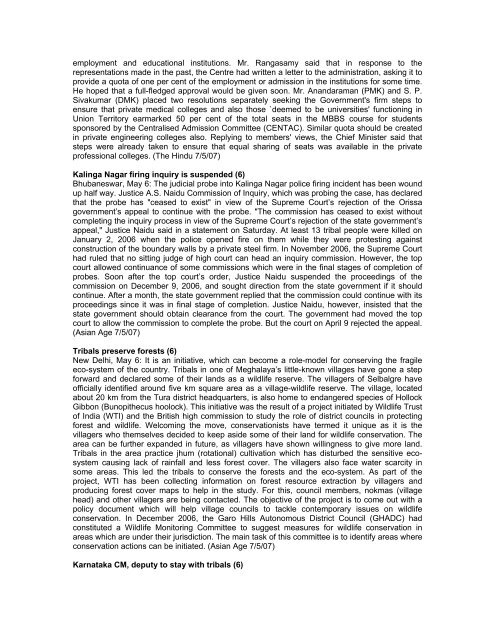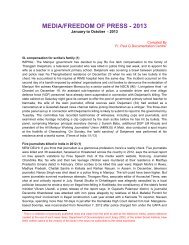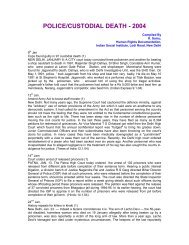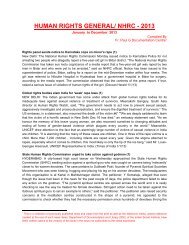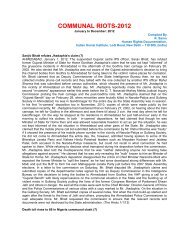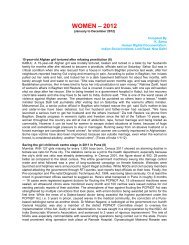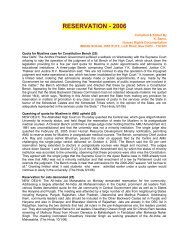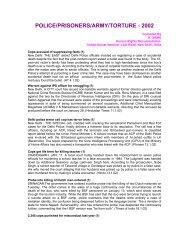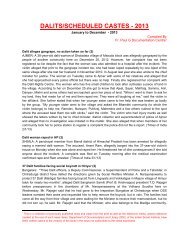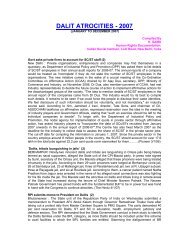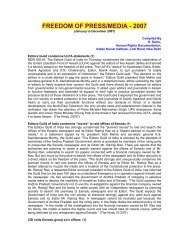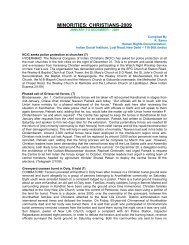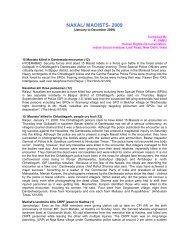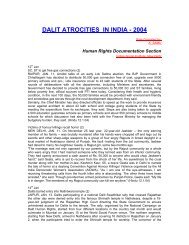play, was all praise for the stagecraft by Kedar Apta. The whole prop on the stage was designedwith an investment of a few hundred rupees. "There is scope to transform it into a street-playalso," Mr. Padhi said. Rabi Narayan Behera, who played the main character `Ghenu', said all theartistes attended a workshop on the tribal language and behaviour to make it look natural. Hissweetheart Jhumuri is part of a tribal dance troupe that visits Bhubaneswar to perform. But, shenever returns. Ghenu then reaches Bhubaneswar in search of Jhumuri. In the process, he too isexploited. He also comes to know how his lover was exploited. He then musters courage tounmask the white-collared exploiters of his clan. (The Hindu 27/4/07)Massacre out in the open, DGP of Chhattisgarh takes back words, orders a probe (6)Raipur, May 5: A day after this newspaper reported that the killing of seven tribals in an“encounter” on March 31 near Bijapur in Chhattisgarh was kept under wraps, the state’s toppolice officer today announced a probe saying the bodies will be exhumed for autopsy. A policeteam is also on its way. Local police have been asked to register a case of murder “againstunknown persons”, said Director General of Police O P Rathore. “The bodies will be exhumedand if evidence is found they were killed by security personnel, legal action will follow,” saidRathore. This is in sharp contrast to what he told The <strong>Indian</strong> Express just days ago: “Gujarat kibimaari sab jagah phaila rahein hai log. The Naxalites are savages, we are not into these things.”This newspaper had reported yesterday that according to villagers, seven tribals from Ponjervillage, who the police claim were Sangham members (Naxalite sympathisers), were picked up byChhattisgarh Armed Police and Salwa Judum, taken to nearby Santoshpur, and killed. “Thesewere Sangham members and we had gone to these villages to conduct a search mission. Therewas an encounter and we were forced to act,” a senior district police officer had said. (<strong>Indian</strong>Express 6/5/07)Move to vacate tribals from cashew plantation areas deplored (6)KORAPUT: Dangar Adhikar Samiti of Koraput district has asked the government to abstain fromusing force on tribals of Machkund region. Sania Sisa, president of the samiti, has reactedsharply to the decision taken by the State government to use police force to evacuate tribals fromthe cashew plantation area within a month. Challenging the move to declare the possession oftribals on the cashew plantation areas as encroachment, he said the government was violatingthe norms of PESA, which was applicable in the undivided Koraput district where no decision oftransfer of land was permissible without the acceptance of the proposal by Palli Sabha orGramsabha. And no such process was adopted to acquire the land. The plantation was done bythe soil conservation department to check soil erosion in big dam areas like Machkund, Kolab,Chitrokunda and Indravati dam area. Further the plantation was taken up on a massive scaleunder different poverty elevation schemes. The intention was that the local community wouldkeep a watch on the plantation and would become the owners of that once the governmentdistributes tree pattas to beneficiaries, he said. But, when the trees bear fruits, the department,allegedly had earned profit by harvesting the crop that was protected by the community. Thingshad got worsened from 1975 when the State government created Cashew DevelopmentCorporation and Soil Conservation Department was asked to hand over the plantation area to thecorporation, he said. After a long struggle by tribals of the region, the Tahsildar of Machkund hadgiven 1500 families tree pattas in these cashew plantation areas. But, surprisingly the same landwas auctioned to another party by the corporation, he said alleging that the State governmentwas taking away the legitimate rights of poor tribals depriving them of their basic source oflivelihood to favour the corporation. (The Hindu 6/5/07)Efforts on to get recognition to STs in Puducherry: Rangasamy (6)Puducherry: Chief Minister N. Rangasamy has said the administration will persist in its efforts toget due recognition for the Scheduled Tribes (STs) residing in Union Territory. He was replying topleas made by R. K. R. Anandaraman (PMK), Leader of the Opposition A. M. H. Nazeem (DMK)and a few other members during a debate on a private member resolution tabled earlier byAnandaraman in the Assembly on Saturday. Mr. Rangasamy said the administration was alreadyseized of the necessity to get recognition for the STs so that they would get reservation in
employment and educational institutions. Mr. Rangasamy said that in response to therepresentations made in the past, the Centre had written a letter to the administration, asking it toprovide a quota of one per cent of the employment or admission in the institutions for some time.He hoped that a full-fledged approval would be given soon. Mr. Anandaraman (PMK) and S. P.Sivakumar (DMK) placed two resolutions separately seeking the Government's firm steps toensure that private medical colleges and also those `deemed to be universities' functioning inUnion Territory earmarked 50 per cent of the total seats in the MBBS course for studentssponsored by the Centralised Admission Committee (CENTAC). Similar quota should be createdin private engineering colleges also. Replying to members' views, the Chief Minister said thatsteps were already taken to ensure that equal sharing of seats was available in the privateprofessional colleges. (The Hindu 7/5/07)Kalinga Nagar firing inquiry is suspended (6)Bhubaneswar, May 6: The judicial probe into Kalinga Nagar police firing incident has been woundup half way. Justice A.S. Naidu Commission of Inquiry, which was probing the case, has declaredthat the probe has "ceased to exist" in view of the Supreme Court’s rejection of the Orissagovernment’s appeal to continue with the probe. "The commission has ceased to exist withoutcompleting the inquiry process in view of the Supreme Court’s rejection of the state government’sappeal," Justice Naidu said in a statement on Saturday. At least 13 tribal people were killed onJanuary 2, 2006 when the police opened fire on them while they were protesting againstconstruction of the boundary walls by a private steel firm. In November 2006, the Supreme Courthad ruled that no sitting judge of high court can head an inquiry commission. However, the topcourt allowed continuance of some commissions which were in the final stages of completion ofprobes. Soon after the top court’s order, Justice Naidu suspended the proceedings of thecommission on December 9, 2006, and sought direction from the state government if it shouldcontinue. After a month, the state government replied that the commission could continue with itsproceedings since it was in final stage of completion. Justice Naidu, however, insisted that thestate government should obtain clearance from the court. The government had moved the topcourt to allow the commission to complete the probe. But the court on April 9 rejected the appeal.(Asian Age 7/5/07)Tribals preserve forests (6)New Delhi, May 6: It is an initiative, which can become a role-model for conserving the fragileeco-system of the country. Tribals in one of Meghalaya’s little-known villages have gone a stepforward and declared some of their lands as a wildlife reserve. The villagers of Selbalgre haveofficially identified around five km square area as a village-wildlife reserve. The village, locatedabout 20 km from the Tura district headquarters, is also home to endangered species of HollockGibbon (Bunopithecus hoolock). This initiative was the result of a project initiated by Wildlife Trustof India (WTI) and the British high commission to study the role of district councils in protectingforest and wildlife. Welcoming the move, conservationists have termed it unique as it is thevillagers who themselves decided to keep aside some of their land for wildlife conservation. Thearea can be further expanded in future, as villagers have shown willingness to give more land.Tribals in the area practice jhum (rotational) cultivation which has disturbed the sensitive ecosystemcausing lack of rainfall and less forest cover. The villagers also face water scarcity insome areas. This led the tribals to conserve the forests and the eco-system. As part of theproject, WTI has been collecting information on forest resource extraction by villagers andproducing forest cover maps to help in the study. For this, council members, nokmas (villagehead) and other villagers are being contacted. The objective of the project is to come out with apolicy document which will help village councils to tackle contemporary issues on wildlifeconservation. In December 2006, the Garo Hills Autonomous District Council (GHADC) hadconstituted a Wildlife Monitoring Committee to suggest measures for wildlife conservation inareas which are under their jurisdiction. The main task of this committee is to identify areas whereconservation actions can be initiated. (Asian Age 7/5/07)Karnataka CM, deputy to stay with tribals (6)
- Page 8 and 9: eported that around 30 per cent of
- Page 10 and 11: Mr. Dinesh told PTI over phone. Pol
- Page 12 and 13: They said they will carry the logs
- Page 15 and 16: designs as there was now awareness
- Page 17 and 18: Rs 15,000 cr for Gujarat tribal dev
- Page 19: the Janmanch leaders to the negotia
- Page 22 and 23: Congress Committee submits that eve
- Page 24 and 25: was formed to orchestrate the plans
- Page 26 and 27: the highest green covers in the cou
- Page 28 and 29: 10,48,669 tribal families go for lo
- Page 32 and 33: Bangalore, May 6: In a first-of-its
- Page 34 and 35: we should not react to Mane and his
- Page 36 and 37: Tribals happy over UNICEF project (
- Page 38 and 39: the water for agricultural use to c
- Page 40 and 41: Meanwhile, the Chhattisgarh Police
- Page 42 and 43: Ratan and Dhirendra from Antarvelia
- Page 44 and 45: festival was carried to numerous nu
- Page 46 and 47: Addressing the gathering, prominent
- Page 48 and 49: characterised by extreme poverty le
- Page 51: Development Commissioner, Revenue S
- Page 54 and 55: Tribal varsity Bill introduced in R
- Page 56 and 57: 2006 gives rights to those who had
- Page 58 and 59: government that the action against
- Page 60 and 61: Rabindra Nath Jarika,VVM leader, Su
- Page 62 and 63: Bhubaneswar : The tribals of backwa
- Page 64 and 65: Jaipur : An interim order of the Ra
- Page 66 and 67: Forest dwellers court arrest (6)New
- Page 68 and 69: forest cover, it said. The matter w
- Page 70 and 71: Minister promised them to look into
- Page 72 and 73: Law Ministry officials, however, no
- Page 74 and 75: and offered themselves for arrest.
- Page 76 and 77: Salwa Judum. Home Minister Ram Vich
- Page 78 and 79: esources hindered them from securin
- Page 80 and 81:
Guwahati: One person was killed and
- Page 82 and 83:
Locals clashed with the rallyists w
- Page 84 and 85:
non-implementation of the Forest Ri
- Page 86 and 87:
gardens and Adivasi villages during
- Page 88 and 89:
state Government. But in the afterm
- Page 90 and 91:
have already claimed their rehabili
- Page 92 and 93:
educational institutions, markets a
- Page 94 and 95:
motivated to become his disciples.
- Page 96 and 97:
amenities," said Bratindi Jena of A


